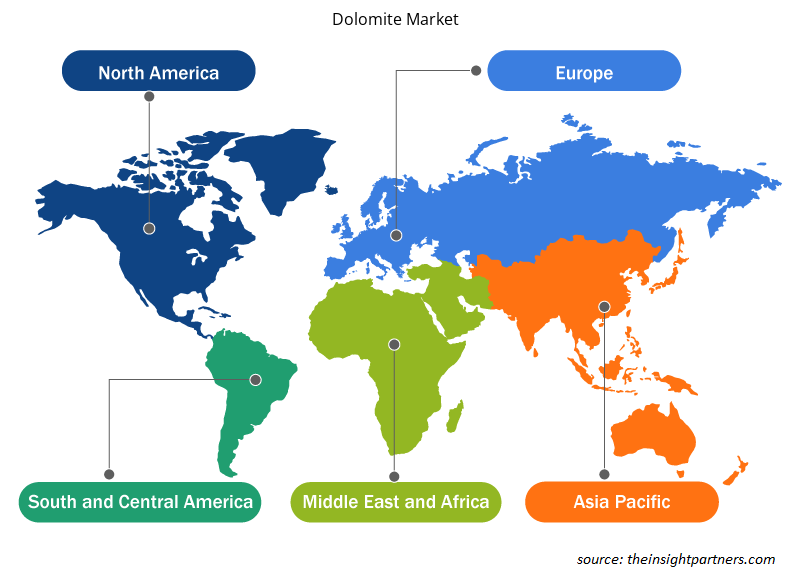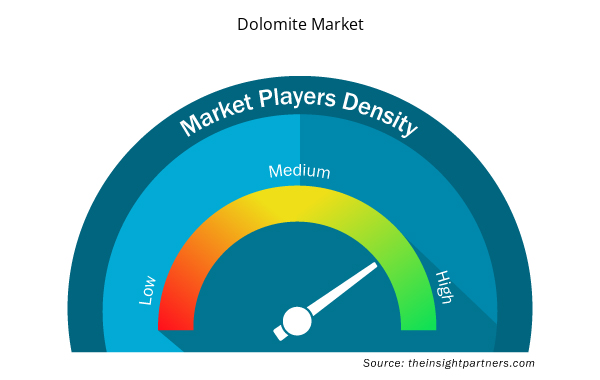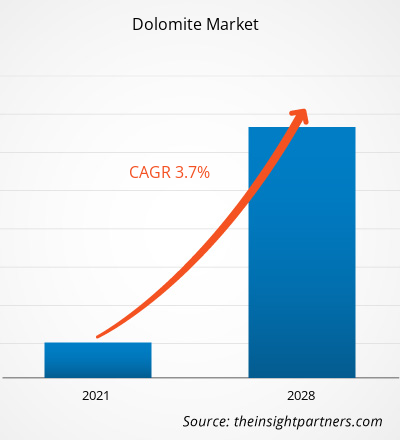预计白云石市场规模将从 2020 年的 217.2797 亿美元增长到 2028 年的 285.5814 亿美元;预计 2021-2028 年期间的复合年增长率为 3.7%。
白云石是铁合金工业的重要材料,广泛用于钢铁厂。由于它能够作为土壤改良剂并平衡土壤 pH 值,因此在农业领域也具有重要应用。石油和天然气、化学品、橡胶、采矿和金属、水处理、制药和化妆品是这种物质的其他重要终端用户。随着这些行业(尤其是在发展中经济体)的迅猛增长,对白云石的需求也在不断增长。然而,采矿活动对环境的不利影响仍然是白云石生产商关注的问题。2020
年,亚太地区占据全球白云石市场的最大收入份额。工业化的快速增长正在推动该地区对交通基础设施的投资。此外,耐火材料产量的增加也推动了亚太地区钢铁行业对白云石的需求。该地区拥有中国和印度等最大经济体,它们是世界上最大的耐火材料消费国之一。中国是世界主要钢铁生产国,而印度的基础设施建设正在呈指数级增长。因此,这些因素为该地区的白云石市场参与者提供了许多增长机会。
定制此报告以满足您的需求
您可以免费定制任何报告,包括本报告的部分内容、国家级分析、Excel 数据包,以及为初创企业和大学提供优惠和折扣
- 获取此报告的关键市场趋势。这个免费样品将包括数据分析,从市场趋势到估计和预测。
COVID-19 疫情对白云石市场的影响
持续的 COVID-19 疫情彻底改变了化学和材料行业的现状,并对白云石采矿市场的增长产生了负面影响。为抗击 SARS-CoV-2 传播而采取的措施加剧了这种情况。由于国家和国际边界突然关闭,运营效率突然扭曲和价值链中断,建筑、钢铁等行业受到了影响。多个工业部门的增长大幅下降导致对白云石的需求减少。采矿作业的关闭阻碍了年度生产业绩。COVID-19 疫情对采矿业的长期影响将取决于封锁期的长短和行业参与者复苏的能力。由于许多国家正计划恢复运营,预计未来几个月全球对白云石的需求将上升。白云石采矿市场参与者正专注于供应和人力的可用性,以实现全面运营水平。
市场洞察
白云石的广泛应用推动白云石市场的增长
白云石在建筑、钢铁、铁合金、陶瓷和玻璃、农业和动物饲料等终端用户行业中有着广泛的应用。其在工业中的偏好和采用取决于岩石的等级。由于其硬度和密度,白云石是建筑行业中常用的物质。在钢铁工业中,白云石有三种形式:原料白云石、煅烧白云石和烧结白云石。白云石用于化学工业和河流修复项目中的酸中和。它还用作牲畜饲料添加剂镁 (MgO) 的来源。白云石用于制造汽车玻璃、建筑玻璃、玻璃纤维等。因此,随着建筑、钢铁、陶瓷和玻璃等各种终端用户行业的增长,对白云石的需求也在增长。
最终用途行业洞察
根据最终用途行业,全球白云石市场细分为农业、动物饲料、陶瓷和玻璃、钢铁、建筑等。2020 年,钢铁行业占据了最大的市场份额。国防、重型工程、能源和建筑等行业的增长在很大程度上推动了钢铁行业的发展。由于快速的城市化和工业化,这些行业的需求不断增加,尤其是在亚太地区、南美洲和中美洲等发展中地区,这是导致世界对白云石需求旺盛的主要因素,从而推动了市场增长。
全球白云石市场的一些主要市场参与者包括北海集团、Calcinor、埃塞尔矿业与工业有限公司、JFE 集团、INCA MINING、LHOIST 集团、Sibelco、RHI Magnesita GmbH、Arihant Min chem 和 Omya AG。
白云石市场区域洞察
Insight Partners 的分析师已详细解释了预测期内影响白云石市场的区域趋势和因素。本节还讨论了北美、欧洲、亚太地区、中东和非洲以及南美和中美洲的白云石市场细分和地理位置。

- 获取白云石市场的区域特定数据
白云石市场报告范围
| 报告属性 | 细节 |
|---|---|
| 2020 年市场规模 | 217.3亿美元 |
| 2028 年市场规模 | 285.6亿美元 |
| 全球复合年增长率(2020 - 2028) | 3.7% |
| 史料 | 2018-2019 |
| 预测期 | 2021-2028 |
| 涵盖的领域 | 按最终用途行业
|
| 覆盖地区和国家 | 北美
|
| 市场领导者和主要公司简介 |
|
白云石市场参与者密度:了解其对商业动态的影响
由于消费者偏好的不断变化、技术进步以及对产品优势的认识不断提高等因素,终端用户需求不断增加,推动了白云石市场快速增长。随着需求的增加,企业正在扩大其产品范围,进行创新以满足消费者需求,并利用新兴趋势,从而进一步推动市场增长。
市场参与者密度是指在特定市场或行业内运营的企业或公司的分布情况。它表明在给定市场空间中,相对于其规模或总市场价值,有多少竞争对手(市场参与者)存在。
在白云石市场运营的主要公司有:
- 北海集团
- 卡尔西诺
- 埃塞尔矿业与工业有限公司
- JFE集团
- 印加矿业
免责声明:上面列出的公司没有按照任何特定顺序排列。

- 获取白云石市场顶级关键参与者概览
报告亮点
- 白云石市场的渐进式行业趋势可帮助参与者制定有效的长期战略
- 发达市场和发展中市场采用的业务增长战略
- 2019 年至 2028 年白云石市场定量分析
- 全球白云石需求量估计
- 波特五力分析说明行业中买家和供应商的效力
- 了解竞争市场状况的最新发展
- 市场趋势和前景以及影响白云石市场增长的因素
- 通过强调支撑商业利益的市场策略来协助决策过程,从而促进市场增长
- 不同节点白云石市场规模
- 详细的市场概况和细分,以及白云石行业动态
- 各地区白云石市场规模及增长潜力
全球白云石市场细分如下:
按最终用途行业
- 农业
- 动物饲料
- 陶瓷和玻璃
- 钢铁
- 建造
- 其他的
公司简介
- 北海集团
- 卡尔西诺
- 埃塞尔矿业与工业有限公司
- JFE集团
- 印加矿业
- 洛伊斯特集团
- 矽比科
- RHI Magnesita 有限公司
- 阿里汉特·明·化学
- 欧米亚公司
- 历史分析(2 年)、基准年、预测(7 年)及复合年增长率
- PEST 和 SWOT 分析
- 市场规模价值/数量 - 全球、区域、国家
- 行业和竞争格局
- Excel 数据集


- Sports Technology Market
- Occupational Health Market
- HVAC Sensors Market
- Redistribution Layer Material Market
- Biopharmaceutical Contract Manufacturing Market
- Artificial Intelligence in Defense Market
- Artificial Intelligence in Healthcare Diagnosis Market
- Arterial Blood Gas Kits Market
- Diaper Packaging Machine Market
- Virtual Pipeline Systems Market

Report Coverage
Revenue forecast, Company Analysis, Industry landscape, Growth factors, and Trends

Segment Covered
This text is related
to segments covered.

Regional Scope
North America, Europe, Asia Pacific, Middle East & Africa, South & Central America

Country Scope
This text is related
to country scope.
常见问题
On the basis of application, construction segment is estimated to register the fastest CAGR in the market over the forecast period. Dolomite is extensively used in the construction sector owing to its hardness and density. Dolomite is utilized for various constructions and building product applications such as asphalt and concrete mixes in a broad variety of building & construction applications such as airport runways, highways, parking lots, curbs, sidewalks, residential streets, roadways, and others. These factors are anticipated to drive the construction segment growth during the projection period.
Wide range of dolomite applications is one of the key drivers for the growth of the global dolomite market. Dolomite has a wide scope of applications in end-user industries such as construction, iron and steel, ferroalloys, ceramics and glass, agriculture, and animal feed. Dolomite is a commonly used substance in the construction industry because of its hardness and density. In the iron and steel industry, dolomite is used in three forms raw dolomite, calcined dolomite, and sintered dolomite. In the iron and steel industry, it is mainly used as a fluxing material for the protection of refractory lining, and as a refractory raw material. Raw dolomite or calcined dolomite is used as a fluxing material. Thus, with the growth of various end-user industries, such as construction, iron and steel, and ceramics and glass, the demand for dolomite is also growing.
China is the leading country of the global dolomite market in Asia Pacific. China is one of the biggest markets for dolomite which is due to the growing refractory production along with the various uses of dolomite in construction and agricultural industry. Manufacturers in China are investing in order to increase the supply of dolomite-based products. Demand for dolomite in China is also increasing which is due to the expansion of crude steel production. Along with this, the increased utilization of dolomite as an aggregator in the construction industry as well as the fertilizer in agriculture industry is driving the growth for dolomite market in China.
Based on application, the iron and steel segment is anticipated to account for the largest share in the global dolomite market. The iron and steel industry is highly driven by the growth of various sectors in such as defense, heavy engineering, energy, and construction. With the ever-increasing demand from these sectors owing to rapid urbanization and industrialization in developing regions such as Asia Pacific, and South and Central America the demand for dolomite is expected to be constantly rise globally.
The major players operating in the global dolomite market are Beihai Group; Calcinor; Essel Mining & Industries Limited; JFE GROUP; INCA MINING; LHOIST GROUP; Sibelco; RHI Magnesita GmbH; Arihant Min chem; Omya AG, and others.
During the forecast period, Asia Pacific is anticipated to account for the largest share in the global dolomite market. Countries in Asia Pacific, such as India, China, Japan, South Korea, and Australia, are witnessing surge in industrialization and urbanization activities. The rapid growth of industrialization is driving investments in transport infrastructure. Further, a rise in refractories production is propelling the demand for dolomite in the iron and steel industries in Asia Pacific. China is a leading producer and consumer of refractories. The growing refractory industry in China, will provide various growth opportunities for the dolomite market players in Asia Pacific.
Trends and growth analysis reports related to Chemicals and Materials : READ MORE..
The List of Companies - Dolomite Market
- Beihai Group
- Calcinor
- Essel Mining & Industries Limited
- JFE GROUP
- INCA MINING
- LHOIST GROUP
- Sibelco
- RHI Magnesita GmbH
- Arihant Min chem
- Omya AG
The Insight Partners performs research in 4 major stages: Data Collection & Secondary Research, Primary Research, Data Analysis and Data Triangulation & Final Review.
- Data Collection and Secondary Research:
As a market research and consulting firm operating from a decade, we have published and advised several client across the globe. First step for any study will start with an assessment of currently available data and insights from existing reports. Further, historical and current market information is collected from Investor Presentations, Annual Reports, SEC Filings, etc., and other information related to company’s performance and market positioning are gathered from Paid Databases (Factiva, Hoovers, and Reuters) and various other publications available in public domain.
Several associations trade associates, technical forums, institutes, societies and organization are accessed to gain technical as well as market related insights through their publications such as research papers, blogs and press releases related to the studies are referred to get cues about the market. Further, white papers, journals, magazines, and other news articles published in last 3 years are scrutinized and analyzed to understand the current market trends.
- Primary Research:
The primarily interview analysis comprise of data obtained from industry participants interview and answers to survey questions gathered by in-house primary team.
For primary research, interviews are conducted with industry experts/CEOs/Marketing Managers/VPs/Subject Matter Experts from both demand and supply side to get a 360-degree view of the market. The primary team conducts several interviews based on the complexity of the markets to understand the various market trends and dynamics which makes research more credible and precise.
A typical research interview fulfils the following functions:
- Provides first-hand information on the market size, market trends, growth trends, competitive landscape, and outlook
- Validates and strengthens in-house secondary research findings
- Develops the analysis team’s expertise and market understanding
Primary research involves email interactions and telephone interviews for each market, category, segment, and sub-segment across geographies. The participants who typically take part in such a process include, but are not limited to:
- Industry participants: VPs, business development managers, market intelligence managers and national sales managers
- Outside experts: Valuation experts, research analysts and key opinion leaders specializing in the electronics and semiconductor industry.
Below is the breakup of our primary respondents by company, designation, and region:

Once we receive the confirmation from primary research sources or primary respondents, we finalize the base year market estimation and forecast the data as per the macroeconomic and microeconomic factors assessed during data collection.
- Data Analysis:
Once data is validated through both secondary as well as primary respondents, we finalize the market estimations by hypothesis formulation and factor analysis at regional and country level.
- Macro-Economic Factor Analysis:
We analyse macroeconomic indicators such the gross domestic product (GDP), increase in the demand for goods and services across industries, technological advancement, regional economic growth, governmental policies, the influence of COVID-19, PEST analysis, and other aspects. This analysis aids in setting benchmarks for various nations/regions and approximating market splits. Additionally, the general trend of the aforementioned components aid in determining the market's development possibilities.
- Country Level Data:
Various factors that are especially aligned to the country are taken into account to determine the market size for a certain area and country, including the presence of vendors, such as headquarters and offices, the country's GDP, demand patterns, and industry growth. To comprehend the market dynamics for the nation, a number of growth variables, inhibitors, application areas, and current market trends are researched. The aforementioned elements aid in determining the country's overall market's growth potential.
- Company Profile:
The “Table of Contents” is formulated by listing and analyzing more than 25 - 30 companies operating in the market ecosystem across geographies. However, we profile only 10 companies as a standard practice in our syndicate reports. These 10 companies comprise leading, emerging, and regional players. Nonetheless, our analysis is not restricted to the 10 listed companies, we also analyze other companies present in the market to develop a holistic view and understand the prevailing trends. The “Company Profiles” section in the report covers key facts, business description, products & services, financial information, SWOT analysis, and key developments. The financial information presented is extracted from the annual reports and official documents of the publicly listed companies. Upon collecting the information for the sections of respective companies, we verify them via various primary sources and then compile the data in respective company profiles. The company level information helps us in deriving the base number as well as in forecasting the market size.
- Developing Base Number:
Aggregation of sales statistics (2020-2022) and macro-economic factor, and other secondary and primary research insights are utilized to arrive at base number and related market shares for 2022. The data gaps are identified in this step and relevant market data is analyzed, collected from paid primary interviews or databases. On finalizing the base year market size, forecasts are developed on the basis of macro-economic, industry and market growth factors and company level analysis.
- Data Triangulation and Final Review:
The market findings and base year market size calculations are validated from supply as well as demand side. Demand side validations are based on macro-economic factor analysis and benchmarks for respective regions and countries. In case of supply side validations, revenues of major companies are estimated (in case not available) based on industry benchmark, approximate number of employees, product portfolio, and primary interviews revenues are gathered. Further revenue from target product/service segment is assessed to avoid overshooting of market statistics. In case of heavy deviations between supply and demand side values, all thes steps are repeated to achieve synchronization.
We follow an iterative model, wherein we share our research findings with Subject Matter Experts (SME’s) and Key Opinion Leaders (KOLs) until consensus view of the market is not formulated – this model negates any drastic deviation in the opinions of experts. Only validated and universally acceptable research findings are quoted in our reports.
We have important check points that we use to validate our research findings – which we call – data triangulation, where we validate the information, we generate from secondary sources with primary interviews and then we re-validate with our internal data bases and Subject matter experts. This comprehensive model enables us to deliver high quality, reliable data in shortest possible time.


 获取此报告的免费样本
获取此报告的免费样本